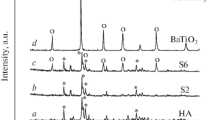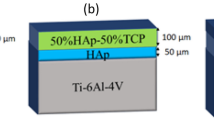Abstract
Composite coatings of Hydroxyapatite (HA) with ceramics, polymers and metals are used to modify the surface structure of implants. In this research, HA/TiO2 composite coating was fabricated by electrophoretic deposition (EPD) on 316 stainless steel substrate. HA/TiO2 composite coatings with 5, 10 and 20 wt.% of TiO2, deposited at 40 V and 90 s as an optimum condition. The samples coated at this condition led to an adherent, continuous and crack-free coating. The influence of TiO2 content was studied by performing different characterization methods such as scanning electron microscopy (SEM), energy dispersive x-ray spectroscopy (EDS), corrosion resistance in simulated body fluid (SBF), coating’s dissolution rate in physiological solution and bond strength to the substrate. The results showed that the higher amount of TiO2 in the composite coating led to increase in bond strength of coating to stainless steel substrate from 3 MPa for HA coating to 5.5 MPa for HA-20 wt.% TiO2 composite coating. In addition, it caused to reduction of corrosion current density of samples in the SBF solution from 18.92 μA/cm2 for HA coating to 6.35 μA/cm2 for HA-20 wt.% TiO2 composite coating.







Similar content being viewed by others
References
J.B. Park and J.D. Bronzino, Biomaterials: Principles and Applications, CRC Press, Boca Raton, 2002, https://doi.org/10.1007/s13398-014-0173-7.2
K.C. Dee, D.A. Puleo, and R. Bizios, An Introduction to Tissue-Biomaterial Interactions, Wiley, New York, 2003
H. Xu, X. Geng, G. Liu, J. Xiao, D. Li, Y. Zhang, P. Zhu, and C. Zhang, Deposition, Nanostructure and Phase Composition of Suspension Plasma-Sprayed Hydroxyapatite Coatings, Ceram. Int., 2016, 42, p 8684–8690. https://doi.org/10.1016/j.ceramint.2016.02.102
E.S. Bogya, Z. Károly, and R. Barabás, Atmospheric Plasma Sprayed Silica-Hydroxyapatite Coatings on Magnesium Alloy Substrates, Ceram. Int., 2015, 41, p 6005–6012. https://doi.org/10.1016/j.ceramint.2015.01.041
P. Rajesh, N. Mohan, Y. Yokogawa, and H. Varma, Pulsed Laser Deposition of Hydroxyapatite on Nanostructured Titanium Towards Drug Eluting Implants, Mater. Sci. Eng. C, 2013, 33, p 2899–2904. https://doi.org/10.1016/j.msec.2013.03.013
D. Sidane, D. Chicot, S. Yala, S. Ziani, H. Khireddine, A. Iost, and X. Decoopman, Study of the Mechanical Behavior and Corrosion Resistance of Hydroxyapatite Sol-Gel Thin Coatings on 316 L Stainless Steel Pre-coated with Titania Film, Thin Solid Films, 2015, 593, p 71–80. https://doi.org/10.1016/j.tsf.2015.09.037
S. Ramesh, A.N. Natasha, C.Y. Tan, L.T. Bang, A. Niakan, J. Purbolaksono, H. Chandran, C.Y. Ching, S. Ramesh, and W.D. Teng, Characteristics and Properties of Hydoxyapatite Derived by Sol-Gel and Wet Chemical Precipitation Methods, Ceram. Int., 2015, https://doi.org/10.1016/j.ceramint.2015.04.105
M.A. Surmeneva and R.A. Surmenev, Microstructure Characterization and Corrosion Behaviour of a Nano-hydroxyapatite Coating Deposited on AZ31 Magnesium Alloy Using Radio Frequency Magnetron Sputtering, Vacuum., 2015, 117, p 60–62. https://doi.org/10.1016/j.vacuum.2015.04.004
A. Molaei, M. Yari, and M.R. Afshar, Modification of Electrophoretic Deposition of Chitosan-Bioactive Glass-Hydroxyapatite Nanocomposite Coatings for Orthopedic Applications by Changing Voltage and Deposition Time, Ceram. Int., 2015, 41, p 14537–14544. https://doi.org/10.1016/j.ceramint.2015.07.170
A. Tahmasbi Rad, M. Solati-Hashjin, N.A.A. Osman, and S. Faghihi, Improved Bio-Physical Performance of Hydroxyapatite Coatings Obtained by Electrophoretic Deposition at Dynamic Voltage, Ceram. Int., 2014, 40, p 12681–12691. https://doi.org/10.1016/j.ceramint.2014.04.116
Y. Huang, Y. Yan, and X. Pang, Electrolytic Deposition of Fluorine-Doped Hydroxyapatite/ZrO2 Films on Titanium for Biomedical Applications, Ceram. Int., 2013, 39, p 245–253. https://doi.org/10.1016/j.ceramint.2012.06.017
H. Te Chen, H.Y. Shu, C.J. Chung, and J.L. He, Assessment of Bone Morphogenic Protein and Hydroxyapatite-Titanium Dioxide Composites for Bone Implant Materials, Surf. Coat. Technol., 2015, 276, p 168–174. https://doi.org/10.1016/j.surfcoat.2015.06.056
X.F. Xiao, R.F. Liu, and Y.Z. Zheng, Characterization of Hydroxyapatite/Titania Composite Coatings Codeposited by a Hydrothermal-Electrochemical Method on Titanium, Surf. Coat. Technol., 2006, 200, p 4406–4413. https://doi.org/10.1016/j.surfcoat.2005.02.205
A. Kobayashi and W. Jiang, Properties of Titania/Hydroxyapatite Nanostructured Coating Produced by Gas Tunnel Type Plasma Spraying, 2009, 83, p 86–91. https://doi.org/10.1016/j.vacuum.2008.03.070
X.F. Xiao and R.F. Liu, Effect of Suspension Stability on Electrophoretic Deposition of Hydroxyapatite Coatings, Mater. Lett., 2006, 60, p 2627–2632. https://doi.org/10.1016/j.matlet.2006.01.048
V.F.C. de Lins, G.F. de Andrade Reis, C.R. de Araujo, T. Matencio, V. De Freitas, C. Lins, G. Francisco, D.A. Reis, C. Roberto, D. Araujo, and T. Matencio, Electrochemical Impedance Spectroscopy and Linear Polarization Applied to Evaluation of Porosity of Phosphate Conversion Coatings on Electrogalvanized Steels, Appl. Surf. Sci., 2006, 253, p 2875–2884. https://doi.org/10.1016/j.apsusc.2006.06.030
T. Kokubo and H. Takadama, How Useful is SBF in Predicting in Vivo Bone Bioactivity?, Biomaterials, 2006, 27, p 2907–2915. https://doi.org/10.1016/j.biomaterials.2006.01.017
ASTM, ASTM D4541-09, Standard Test Method for Pull-Off Strength of Coatings Using Portable Adhesion, ASTM Int., 2014, https://doi.org/10.1520/d4541-09e01.2
M. Yaszemski and D.J. Trantolo, Biomaterials in Orthopedics, CRC Press, Boca Raton, 2003
Y.X. Pang and X. Bao, Influence of Temperature, Ripening Time and Calcination on the Morphology and Crystallinity of Hydroxyapatite Nanoparticles, J. Eur. Ceram. Soc., 2003, 23, p 1697–1704. https://doi.org/10.1016/s0955-2219(02)00413-2
B.D. Ratner, A.S. Hoffman, F.J. Schoen, and J.E. Lemons, Biomaterials Science: An Introduction to Materials in Medicine, Academic Press, Amsterdam, 2004
Author information
Authors and Affiliations
Corresponding author
Rights and permissions
About this article
Cite this article
Amirnejad, M., Afshar, A. & Salehi, S. The Effect of Titanium Dioxide (TiO2) Nanoparticles on Hydroxyapatite (HA)/TiO2 Composite Coating Fabricated by Electrophoretic Deposition (EPD). J. of Materi Eng and Perform 27, 2338–2344 (2018). https://doi.org/10.1007/s11665-018-3342-6
Received:
Revised:
Published:
Issue Date:
DOI: https://doi.org/10.1007/s11665-018-3342-6




